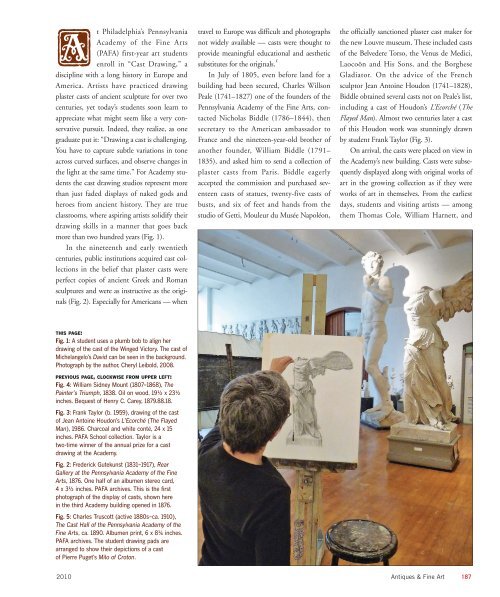The Historic Cast Collection at the Pennsylvania Academy of the ...
The Historic Cast Collection at the Pennsylvania Academy of the ...
The Historic Cast Collection at the Pennsylvania Academy of the ...
You also want an ePaper? Increase the reach of your titles
YUMPU automatically turns print PDFs into web optimized ePapers that Google loves.
At Philadelphia’s <strong>Pennsylvania</strong><br />
<strong>Academy</strong> <strong>of</strong> <strong>the</strong> Fine Arts<br />
(PAFA) first-year art students<br />
enroll in “<strong>Cast</strong> Drawing,” a<br />
discipline with a long history in Europe and<br />
America. Artists have practiced drawing<br />
plaster casts <strong>of</strong> ancient sculpture for over two<br />
centuries, yet today’s students soon learn to<br />
appreci<strong>at</strong>e wh<strong>at</strong> might seem like a very conserv<strong>at</strong>ive<br />
pursuit. Indeed, <strong>the</strong>y realize, as one<br />
gradu<strong>at</strong>e put it: “Drawing a cast is challenging.<br />
You have to capture subtle vari<strong>at</strong>ions in tone<br />
across curved surfaces, and observe changes in<br />
<strong>the</strong> light <strong>at</strong> <strong>the</strong> same time.” For <strong>Academy</strong> students<br />
<strong>the</strong> cast drawing studios represent more<br />
than just faded displays <strong>of</strong> naked gods and<br />
heroes from ancient history. <strong>The</strong>y are true<br />
classrooms, where aspiring artists solidify <strong>the</strong>ir<br />
drawing skills in a manner th<strong>at</strong> goes back<br />
more than two hundred years (Fig. 1).<br />
In <strong>the</strong> nineteenth and early twentieth<br />
centuries, public institutions acquired cast collections<br />
in <strong>the</strong> belief th<strong>at</strong> plaster casts were<br />
perfect copies <strong>of</strong> ancient Greek and Roman<br />
sculptures and were as instructive as <strong>the</strong> originals<br />
(Fig. 2). Especially for Americans — when<br />
THIS PAGE:<br />
Fig. 1: A student uses a plumb bob to align her<br />
drawing <strong>of</strong> <strong>the</strong> cast <strong>of</strong> <strong>the</strong> Winged Victory. <strong>The</strong> cast <strong>of</strong><br />
Michelangelo’s David can be seen in <strong>the</strong> background.<br />
Photograph by <strong>the</strong> author, Cheryl Leibold, 2008.<br />
PREVIOUS PAGE, CLOCKWISE FROM UPPER LEFT:<br />
Fig. 4: William Sidney Mount (1807–1868), <strong>The</strong><br />
Painter’s Triumph, 1838. Oil on wood, 19˙ x 23˙<br />
inches. Bequest <strong>of</strong> Henry C. Carey, 1879.88.18.<br />
Fig. 3: Frank Taylor (b. 1959), drawing <strong>of</strong> <strong>the</strong> cast<br />
<strong>of</strong> Jean Antoine Houdon’s L’Ecorché (<strong>The</strong> Flayed<br />
Man), 1986. Charcoal and white conté, 24 x 15<br />
inches. PAFA School collection. Taylor is a<br />
two-time winner <strong>of</strong> <strong>the</strong> annual prize for a cast<br />
drawing <strong>at</strong> <strong>the</strong> <strong>Academy</strong>.<br />
Fig. 2: Frederick Gutekunst (1831–1917), Rear<br />
Gallery <strong>at</strong> <strong>the</strong> <strong>Pennsylvania</strong> <strong>Academy</strong> <strong>of</strong> <strong>the</strong> Fine<br />
Arts, 1876. One half <strong>of</strong> an albumen stereo card,<br />
4 x 3˙ inches. PAFA archives. This is <strong>the</strong> first<br />
photograph <strong>of</strong> <strong>the</strong> display <strong>of</strong> casts, shown here<br />
in <strong>the</strong> third <strong>Academy</strong> building opened in 1876.<br />
Fig. 5: Charles Truscott (active 1880s–ca. 1910),<br />
<strong>The</strong> <strong>Cast</strong> Hall <strong>of</strong> <strong>the</strong> <strong>Pennsylvania</strong> <strong>Academy</strong> <strong>of</strong> <strong>the</strong><br />
Fine Arts, ca. 1890. Albumen print, 6 x 8© inches.<br />
PAFA archives. <strong>The</strong> student drawing pads are<br />
arranged to show <strong>the</strong>ir depictions <strong>of</strong> a cast<br />
<strong>of</strong> Pierre Puget’s Milo <strong>of</strong> Croton.<br />
travel to Europe was difficult and photographs<br />
not widely available — casts were thought to<br />
provide meaningful educ<strong>at</strong>ional and aes<strong>the</strong>tic<br />
substitutes for <strong>the</strong> originals. 1<br />
In July <strong>of</strong> 1805, even before land for a<br />
building had been secured, Charles Willson<br />
Peale (1741–1827) one <strong>of</strong> <strong>the</strong> founders <strong>of</strong> <strong>the</strong><br />
<strong>Pennsylvania</strong> <strong>Academy</strong> <strong>of</strong> <strong>the</strong> Fine Arts, contacted<br />
Nicholas Biddle (1786–1844), <strong>the</strong>n<br />
secretary to <strong>the</strong> American ambassador to<br />
France and <strong>the</strong> nineteen-year-old bro<strong>the</strong>r <strong>of</strong><br />
ano<strong>the</strong>r founder, William Biddle (1791–<br />
1835), and asked him to send a collection <strong>of</strong><br />
plaster casts from Paris. Biddle eagerly<br />
accepted <strong>the</strong> commission and purchased seventeen<br />
casts <strong>of</strong> st<strong>at</strong>ues, twenty-five casts <strong>of</strong><br />
busts, and six <strong>of</strong> feet and hands from <strong>the</strong><br />
studio <strong>of</strong> Getti, Mouleur du Musée Napoléon,<br />
<strong>the</strong> <strong>of</strong>ficially sanctioned plaster cast maker for<br />
<strong>the</strong> new Louvre museum. <strong>The</strong>se included casts<br />
<strong>of</strong> <strong>the</strong> Belvedere Torso, <strong>the</strong> Venus de Medici,<br />
Laocoön and His Sons, and <strong>the</strong> Borghese<br />
Gladi<strong>at</strong>or. On <strong>the</strong> advice <strong>of</strong> <strong>the</strong> French<br />
sculptor Jean Antoine Houdon (1741–1828),<br />
Biddle obtained several casts not on Peale’s list,<br />
including a cast <strong>of</strong> Houdon’s L’Ecorché (<strong>The</strong><br />
Flayed Man). Almost two centuries l<strong>at</strong>er a cast<br />
<strong>of</strong> this Houdon work was stunningly drawn<br />
by student Frank Taylor (Fig. 3).<br />
On arrival, <strong>the</strong> casts were placed on view in<br />
<strong>the</strong> <strong>Academy</strong>’s new building. <strong>Cast</strong>s were subsequently<br />
displayed along with original works <strong>of</strong><br />
art in <strong>the</strong> growing collection as if <strong>the</strong>y were<br />
works <strong>of</strong> art in <strong>the</strong>mselves. From <strong>the</strong> earliest<br />
days, students and visiting artists — among<br />
<strong>the</strong>m Thomas Cole, William Harnett, and<br />
2010 Antiques & Fine Art 187








